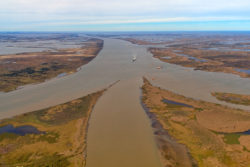Coastal
The End of the Great River
A photographer looks at the changing landscapes of the river’s final miles
Published: December 1, 2019
Last Updated: May 13, 2020

Matthew D. White
Head of Passes, End of Mississippi River, Plaquemines Parish, Louisiana.
White finds the changeable, sometimes remote terrain of the lower Mississippi soothing, despite its mutability; over the nearly twenty years of the project, he’s seen changes from season to season and the longer cycle of land gain and, more often, loss. While the land lasts, White plans to be out there, capturing this underrecorded, imperiled, and unique American landscape.
Matthew D. White was born in Endwell, New York, and began taking photographs as a teenager. He has lived in New Orleans since 2003 with his wife and daughter. He holds a master’s degree in Jazz Studies from the University of New Orleans, and when not photographing, can be seen performing on guitar with many different combos in New Orleans.
 This article was made possible by the BHP-funded project, Coastal Impacts: An Integrated Approach for Community Adaptation, Understanding, and Planning, which will assist local communities to build intergenerational coastal literacy through community conversations around books, film, and exhibitions, fostering greater understanding of and support for coastal restoration projects.
This article was made possible by the BHP-funded project, Coastal Impacts: An Integrated Approach for Community Adaptation, Understanding, and Planning, which will assist local communities to build intergenerational coastal literacy through community conversations around books, film, and exhibitions, fostering greater understanding of and support for coastal restoration projects.



